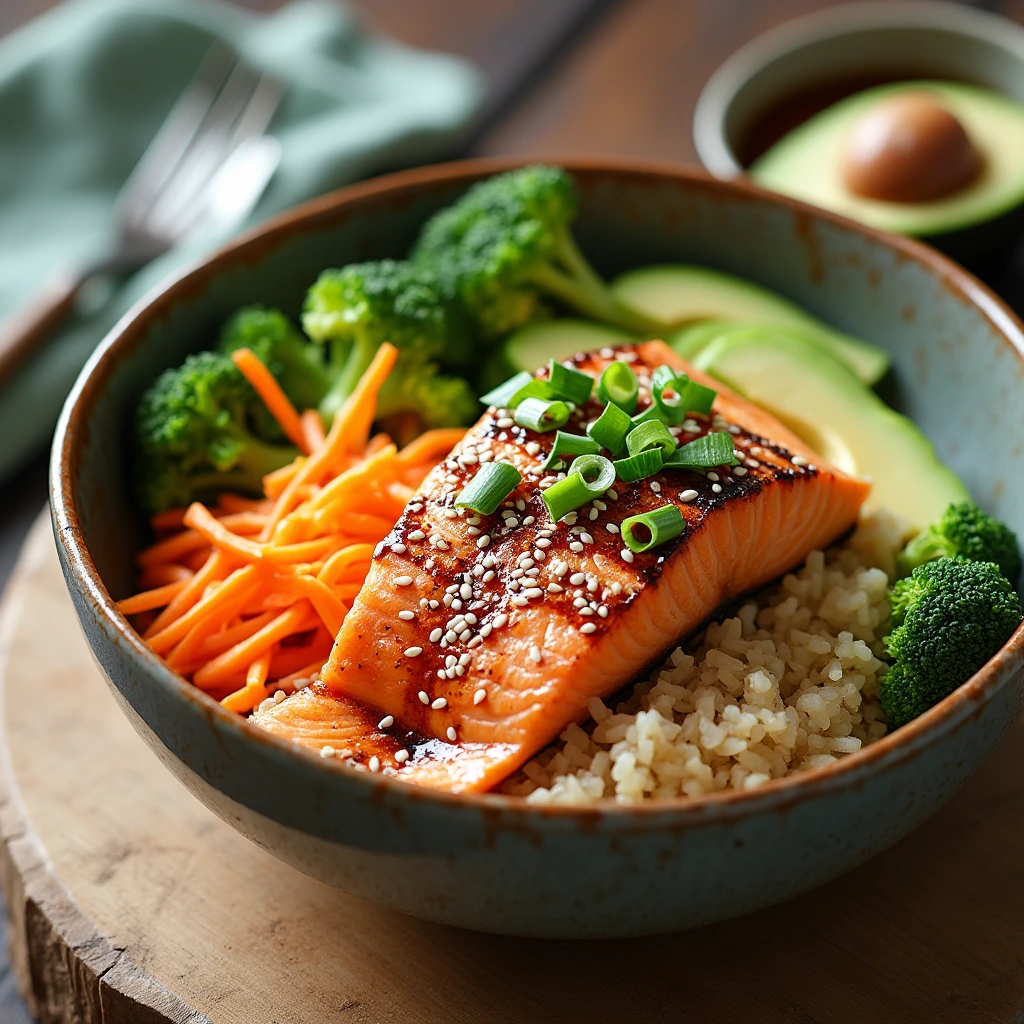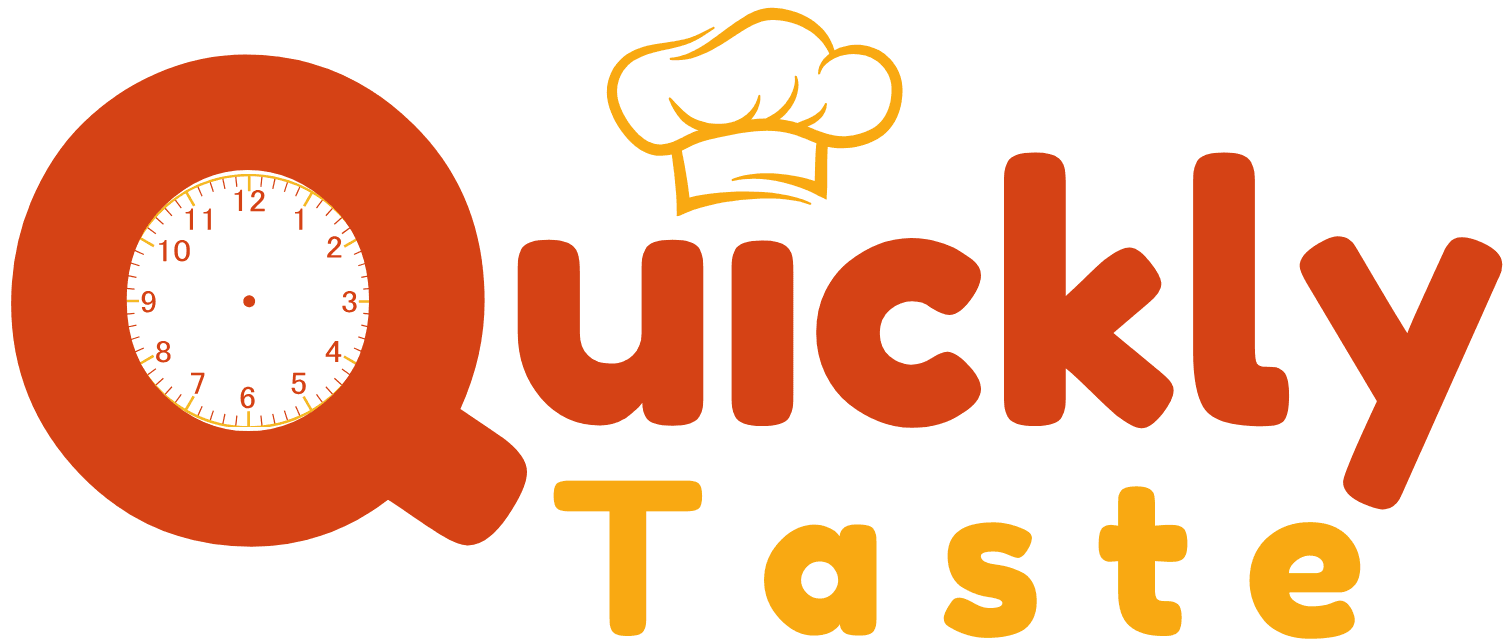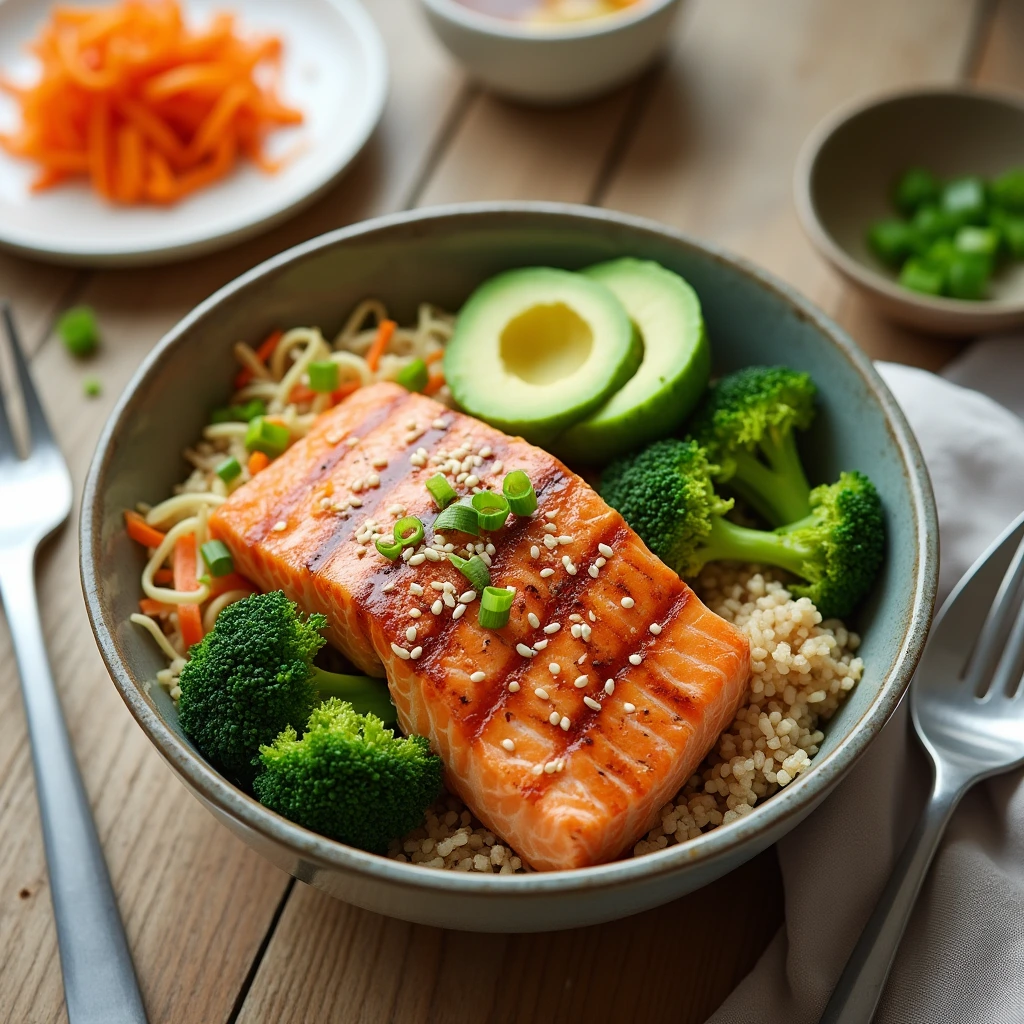About the Recipe
Salmon bowls have quickly become a favorite meal option for those seeking a combination of health and flavor. These bowls bring together vibrant ingredients and balanced flavors, making them perfect for quick lunches, family dinners, or meal prep. Their versatility ensures they fit seamlessly into various dietary preferences.

Why Salmon Bowls Are Popular
Their adaptability attracts many people—you can pair grains, vegetables, and toppings to match your taste or dietary needs. For instance, some prefer Mediterranean-inspired flavors, while others opt for spicy or low-carb options. Moreover, their visual appeal makes them a hit on social media platforms, where colorful, well-presented dishes stand out.
Health Benefits of Salmon
Salmon offers numerous health benefits. It contains omega-3 fatty acids, which support heart and brain health, as well as high-quality protein that aids in muscle repair and growth. Additionally, it provides essential nutrients like vitamins B12 and D, which help boost energy and immunity. When paired with whole grains and vegetables, salmon bowls deliver a complete and nourishing meal.
Overview of the Dish
Typically, a salmon bowl features a flavorful protein base, fresh or cooked vegetables, and a delicious dressing. The combination of taste, texture, and nutrition makes salmon bowls an excellent choice for any occasion.
Why Choose Salmon for Your Bowl?
Salmon is an exceptional choice for creating delicious and nutritious bowls. Its rich flavor, impressive nutritional profile, and versatility make it a standout ingredient for any meal.
Nutritional Value of Salmon
Salmon is packed with high-quality protein, which supports muscle repair and growth, along with essential vitamins and minerals like B12, D, and selenium. These nutrients boost energy levels, enhance brain function, and strengthen the immune system, making salmon a superfood that contributes to overall health.
Omega-3 Fatty Acids and Their Benefits
Salmon is one of the best natural sources of omega-3 fatty acids, which play a crucial role in maintaining heart health, reducing inflammation, and supporting cognitive function. These healthy fats also promote glowing skin and strong hair, adding to salmon’s appeal as a health-boosting ingredient.
Versatility of Salmon in Recipes
Salmon adapts effortlessly to various cooking styles and flavor profiles. It pairs well with grains, greens, and vegetables, offering endless possibilities for customization. Whether grilled, baked, or pan-seared, its rich texture and taste shine in any dish.
With its nutritional benefits and culinary flexibility, salmon is an ideal base for creating bowls that are both wholesome and satisfying.
Essential Ingredients for a Perfect Salmon Bowl
Crafting a delicious salmon bowl begins with carefully selecting high-quality ingredients. Each component plays a key role in creating a balanced, flavorful, and visually stunning dish.
Fresh and Sustainable Salmon
The star of any salmon bowl is, of course, the salmon itself. To ensure the best results, choose fresh, sustainably sourced salmon that delivers both flavor and nutritional value. For example, wild-caught salmon offers a robust taste, while responsibly farmed options can be equally satisfying. Additionally, look for vibrant, firm flesh to confirm its freshness.
Base Options (Rice, Quinoa, Greens)
Next, the base provides the foundation for your bowl. Grains like brown rice, quinoa, or farro are excellent for hearty textures and valuable nutrients. Alternatively, leafy greens such as kale, spinach, or arugula work well for lighter options. Moreover, low-carb substitutes like cauliflower rice or zucchini noodles cater to specific dietary needs.
Vegetables, Toppings, and Dressings
Finally, vegetables and toppings complete the dish. Fresh or roasted veggies like avocado, cucumber, and sweet potatoes add vibrant color and texture. Additionally, toppings such as sesame seeds, herbs, or nuts provide extra flavor. Meanwhile, a dressing—like sriracha mayo or lemon vinaigrette—brings everything together, ensuring the bowl is both cohesive and satisfying.
With these elements, your salmon bowl will be a perfect balance of flavor, nutrition, and visual appeal.
Preparing the Salmon
The salmon is the star of your bowl, so proper preparation is essential. From selecting the right type to cooking and seasoning, each step plays a key role in achieving a flavorful and tender result.
Choosing the Right Type of Salmon
Start by selecting high-quality salmon. Wild-caught varieties, such as sockeye or coho, offer bold flavors and a firmer texture, while farmed salmon, like Atlantic salmon, provides a milder taste and higher fat content. Always look for fresh, bright-colored flesh with no unpleasant odor. Additionally, check for sustainability certifications to ensure eco-friendly choices.
Cooking Methods
The way you cook salmon greatly influences its taste and texture. Grilling adds a smoky flavor and charred edges, perfect for bold marinades. Baking ensures even cooking and works well for seasoning-heavy recipes. Pan-searing creates a crispy, golden crust while keeping the interior tender. Whichever method you choose, avoid overcooking to preserve the fish’s natural moisture.
Tips for Perfect Seasoning
Seasoning enhances the salmon’s flavor. For simplicity, use olive oil, salt, and pepper. For a bolder profile, try marinades with soy sauce, lemon, garlic, or herbs like dill. Additionally, consider spice blends or a drizzle of honey for added complexity.
With the right preparation, your salmon will be both flavorful and perfectly cooked.
Crafting the Perfect Base
The base of a salmon bowl provides structure, texture, and a nutritional foundation. Whether you prefer hearty grains, low-carb options, or fresh greens, there are plenty of choices to suit your preferences and dietary needs.
Rice Varieties for Salmon Bowls
Rice is a classic and versatile base for salmon bowls. Brown rice is a popular choice for its nutty flavor and high fiber content, which supports digestion. Wild rice adds a unique, earthy taste and is rich in protein and antioxidants. For a milder option, jasmine or sushi rice works well, especially in Asian-inspired bowls. Consider seasoning your rice with sesame oil, lime, or herbs for added flavor.
Low-Carb Alternatives: Quinoa, Cauliflower Rice
For lighter or low-carb options, quinoa and cauliflower rice are excellent substitutes. Quinoa offers a nutty flavor, high protein content, and all nine essential amino acids, making it a superfood favorite. Meanwhile, cauliflower rice provides a low-calorie, gluten-free alternative with a neutral taste that pairs well with bold flavors.
Greens and Their Benefits
Leafy greens like spinach, kale, or arugula create a fresh, nutrient-packed base. They are rich in vitamins A, C, and K, along with antioxidants that promote overall health. Pairing greens with roasted salmon and tangy dressings ensures a vibrant and balanced bowl.
Choose your base to complement your salmon bowl’s flavors while meeting your dietary goals.
Best Vegetables and Toppings for Salmon Bowls
The right vegetables and toppings elevate salmon bowls by adding flavor, texture, and nutritional value. Mixing fresh, roasted, or fermented ingredients ensures a well-rounded and satisfying meal.
Popular Choices: Avocado, Cucumber, Carrots
Fresh vegetables like avocado, cucumber, and carrots are staples in salmon bowls. Avocado adds creaminess and healthy fats, perfectly complementing the richness of salmon. Crisp cucumber provides a refreshing crunch, while carrots deliver sweetness and a vibrant pop of color. Consider julienning or spiralizing carrots for a unique texture.
Fermented Additions: Kimchi, Pickled Ginger
Fermented toppings introduce tangy, umami-rich flavors that enhance the bowl’s complexity. Kimchi adds spice and probiotics, supporting gut health. Pickled ginger offers a zesty bite that pairs particularly well with Asian-inspired bowls, balancing the richness of salmon and heavier dressings.
Nuts and Seeds for Texture
Crunchy additions like sesame seeds, crushed almonds, or pumpkin seeds not only provide texture but also boost the bowl’s nutritional value with healthy fats and proteins. Toasted sesame seeds add an earthy flavor, while nuts like almonds or walnuts bring a satisfying crunch.
By combining fresh, fermented, and crunchy elements, you can create a salmon bowl bursting with flavor and diverse textures.
Popular Sauce Options for Salmon Bowls
A well-chosen sauce can transform a salmon bowl, tying together flavors while elevating the dish’s appeal. With options ranging from creamy to spicy, there’s something to complement every palate.
Creamy Sauces: Tahini, Yogurt-Based Dressings
For a rich and smooth option, creamy sauces work wonderfully. Tahini, for example, offers a nutty flavor that pairs perfectly with roasted vegetables and grains. Similarly, yogurt-based dressings, such as lemon-dill or garlic-herb, bring a refreshing tang while keeping the dish light. Moreover, adding olive oil, honey, or fresh herbs to these dressings can enhance their complexity.
Asian-Inspired: Soy Sauce, Sesame Dressing
When aiming for bold, umami flavors, Asian-inspired sauces are a great choice. Soy sauce, combined with sesame oil, ginger, and garlic, creates a savory base for any salmon bowl. Additionally, sesame dressing, made from toasted sesame seeds, vinegar, and soy sauce, complements rice or greens beautifully. To balance the saltiness, you might also include a touch of honey.
Spicy Options: Sriracha Mayo, Chili Oil
If you love heat, spicy sauces are essential. Sriracha mayo, for instance, adds creamy richness with a kick of spice, balancing the flavors of the bowl. Furthermore, chili oil delivers an aromatic heat that works especially well with grilled or pan-seared salmon.
By thoughtfully choosing your sauce, you can ensure your salmon bowl achieves a perfectly cohesive and flavorful experience.
Creative Salmon Bowl Variations
Salmon bowls are endlessly versatile, making them perfect for experimenting with different global flavors. These creative variations bring unique twists to your meal while maintaining balance and nutrition.
Hawaiian-Inspired Poke Bowls
Hawaiian poke bowls highlight fresh, raw salmon paired with light and refreshing ingredients. Start with a base of sushi rice or mixed greens. Top it with diced salmon marinated in soy sauce, sesame oil, and a hint of lime. Add avocado, cucumber, seaweed, and edamame for texture. Sprinkle sesame seeds or furikake for extra flavor, and finish with a drizzle of spicy mayo or ponzu sauce.
Mediterranean Salmon Bowls
For a Mediterranean twist, use quinoa or couscous as the base. Pair baked or grilled salmon with cherry tomatoes, cucumbers, olives, and red onion. Add a dollop of hummus or tzatziki sauce for creaminess. Top with fresh parsley, crumbled feta cheese, and a squeeze of lemon for a bright, tangy finish.
Japanese-Inspired Sushi Bowls
Sushi bowls capture the essence of traditional sushi in a deconstructed form. Use sushi rice as the base, then layer sliced or seared salmon, avocado, pickled ginger, and shredded nori. Garnish with sesame seeds, wasabi, and soy sauce or spicy sriracha mayo for a bold, flavorful experience.
These variations showcase the versatility of salmon bowls, making them exciting and adaptable for any palate.
Step-by-Step Recipe: A Classic Salmon Bowl
This recipe combines fresh ingredients with simple preparation to create a delicious and balanced salmon bowl. Perfect for any occasion, it’s easy to follow and packed with flavor.
Ingredients List
- For the Salmon:
- 2 salmon fillets (4–6 oz each)
- 1 tbsp olive oil
- 1 tsp garlic powder
- Salt and pepper to taste
- For the Base:
- 2 cups cooked brown rice or quinoa
- For the Vegetables:
- 1 cup steamed broccoli
- 1/2 cup shredded carrots
- 1/2 avocado, sliced
- For the Sauce:
- 2 tbsp soy sauce
- 1 tbsp sesame oil
- 1 tsp honey
Instructions for Preparation
- Cook the Salmon: To start, preheat a pan over medium heat. Then, rub the salmon with olive oil, garlic powder, salt, and pepper. Next, cook skin-side down for 4–5 minutes, flip, and cook for an additional 2–3 minutes.
- Prepare the Sauce: Meanwhile, whisk together soy sauce, sesame oil, and honey in a small bowl. Set it aside.
- Cook the Base: While the salmon is cooking, prepare brown rice or quinoa according to package instructions.
Assembly and Presentation Tips
First, layer the cooked rice in a bowl, followed by broccoli, carrots, and avocado. Then, place the salmon on top and drizzle with the prepared sauce. Finally, garnish with sesame seeds or green onions for an elegant finish.
With these steps, you’ll have a classic salmon bowl that is simple, nutritious, and bursting with flavor!
FAQs
How to Make a Delicious Salmon Marinade?
Creating a flavorful salmon marinade is easy and enhances the dish significantly. Combine olive oil, soy sauce, fresh lemon juice, minced garlic, and a touch of honey or maple syrup for a balance of savory and sweet flavors. For extra zest, add fresh herbs like dill or parsley, or spice it up with chili flakes or ginger. Marinate the salmon for at least 30 minutes, but no more than 2 hours, to avoid overpowering the fish’s natural flavor.
What Is the Best Wine to Pair With Salmon?
The ideal wine pairing depends on how the salmon is prepared. For grilled or roasted salmon, opt for a medium-bodied white wine like Chardonnay or a light red like Pinot Noir, which complements its richness. If the salmon has an Asian or citrus glaze, a Riesling or Sauvignon Blanc enhances its tangy flavors.
Can I Eat Cooked Salmon After 5 Days?
Cooked salmon is best consumed within 3–4 days when stored in an airtight container in the refrigerator. After five days, the fish may lose its quality and could pose a food safety risk. For longer storage, freeze cooked salmon for up to three months.
What Is the Best Wine to Serve With Salmon?
A versatile choice is Pinot Noir, known for its fruity, earthy notes that pair well with salmon’s rich texture. For a white wine option, try a crisp Sauvignon Blanc or a buttery Chardonnay to complement the flavors. Matching the wine to the preparation method ensures a perfect pairing.
More
To enhance your understanding of salmon bowls and provide inspiration for your culinary creations, here are some external resources to explore. For those looking to master the art of cooking salmon, the USDA’s Safe Seafood Cooking Guidelines offer tips on ensuring proper preparation and storage. If you’re interested in sustainable seafood choices, the Monterey Bay Aquarium Seafood Watch provides updated recommendations on environmentally friendly options. For creative sauce ideas, websites like AllRecipes and Food Network feature a wide range of dressing recipes tailored to salmon dishes.
If you’re curious about pairing wine with salmon, consult Wine Folly, which offers detailed guides on matching wine varieties to various salmon preparations. Additionally, Healthline provides in-depth articles on the nutritional benefits of salmon, helping you understand why it’s a top choice for a healthy diet.
For meal prep enthusiasts, visit Tasty’s Meal Prep Ideas for time-saving tips and storage tricks. Lastly, the BBC Good Food Guide showcases global variations of salmon bowls, inspiring you to try new flavors and techniques. These resources will help you elevate your salmon bowl game while ensuring your meals are delicious, healthy, and sustainable.
You can discover more recipes on our website:
Conclusion
Salmon bowls are a perfect combination of flavor, nutrition, and versatility, making them a must-try for any meal. Not only are they packed with omega-3s, protein, and vibrant ingredients, but they also cater to various tastes and dietary needs. Furthermore, salmon bowls allow you to explore your creativity in the kitchen. By experimenting with different bases, sauces, and toppings, you can craft unique combinations that suit your preferences. Whether you’re preparing a quick lunch, a hearty dinner, or meal-prepping for the week, these bowls are satisfying, delicious, and easy to make. Ultimately, dive into this culinary adventure and enjoy the endless possibilities salmon bowls offer!

